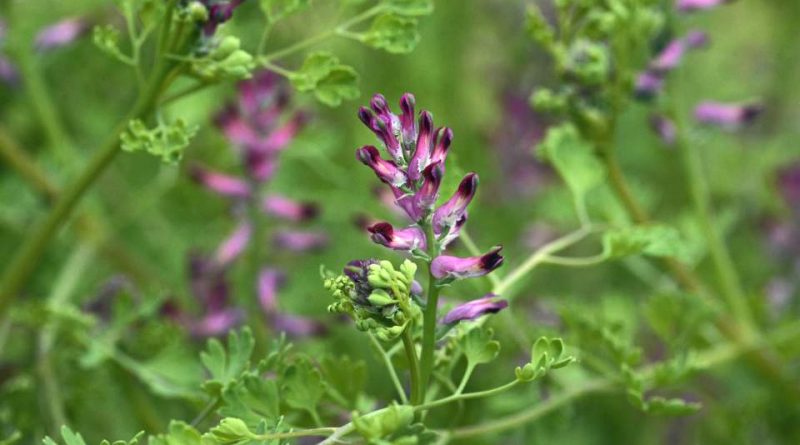Fumaria officinalis
Fumaria officinalis
The common fumitory (Fumaria officinalis L., 1753) is a herbaceous species belonging to the Papaveraceae family.
Systematics –
From a systematic point of view it belongs to:
Eukaryota Domain,
Kingdom Plantae,
Subarign Tracheobionta,
Spermatophyta superdivision,
Magnoliophyta Division,
Magnoliopsida class,
Subclass Magnoliidae,
Ranunculales Order,
Fumariaceae family,
Genus Fumaria,
F. officinalis species.
The following terms are synonymous:
– Fumaria angustifolia Gilib .;
– Diffused fumitory Arn. ex Parl .;
– Fumaria gasparinii Bab .;
– Loisel medium flue .;
– Fumaria officinarum Neck .;
– Fumaria petteri V.Ten .;
– Fumaria pulchella Salisb ..
Etymology –
The term Fumaria comes from fúmus smoke: due to the greyish appearance of the leaves.
The specific epithet officinalis comes from a medieval laboratory workshop: as a plant usable in pharmaceuticals, herbal medicine, liqueurs, perfumery and the like.
Geographic Distribution and Habitat –
Fumaria officinalis is a plant widespread in the Mediterranean basin and in northern Europe and with a Eurasian distribution.
This plant is present in all regions of Italy.
Its habitat is that of meadows, fields, roads, in the plains and in the hills, it is mainly present in cultivated fields, where it is considered a pest; usually it prefers areas of loose and fertile soil, especially due to the presence of nitrogenous compounds, sometimes decalcified and subacid, from sea level to the lower mountain belt, sometimes even higher.
Description –
Fumaria officinalis is a herbaceous plant that reaches an average height of 20-30 cm, up to a maximum of 50 cm.
Its small stems are bluish green, hairless upright or prostrate and partially climbing.
The leaves are long and slender, petiolate and deeply divided into thin segments.
The flowers are gathered in lasse racemose inflorescences carrying over twenty flowers; they have a purple pink color, darker at the apex and vaguely resembling a sock.
The fruit is a smooth, elliptical or spherical capsule (achene), compressed, trunk or retused at the apex, slightly reduced at the base, with a smooth or roughly wrinkled surface, brown-olive, with a diameter of 2 mm, carried by a patent erect peduncle long 2 times the bract.
Cultivation –
Fumaria officinalis is a plant that prefers light and well-drained soil in a sunny position. In some cases it can become a weed even if it is quite easy to control with manual weeding.
The flowers are rarely visited by insects, but they are self-fertile and usually go to seed.
Propagation is by seed, with spring sowing in situ. Normally there is very little need to sow this seed as plants normally self-sow.
Customs and Traditions –
The common fumitory has been highly appreciated at least since Roman times for its invigorating and purifying effect of the blood on the body.
It is particularly valuable in the treatment of all visceral obstructions, in particular those of the liver, in scurvy affections and in annoying eruptive skin diseases, in particular eczema (for which it can be taken internally and externally).
The herb is antispasmodic, aperient, cholagogue, slightly diaphoretic, slightly diuretic, laxative and weakly toned.
It is used in herbal medicine, and is a medicinal product due to its fumaric acid content, active, among other things, for the treatment of psoriasis. It constitutes the main ingredient of a widespread preparation for self-medication.
Furthermore, a yellow dye is obtained from the flowers.
A decoction produces a healing lotion for the “milk crust” on the children’s scalp.
Contains the alkaloids: Fumarin (or Protopin), Fumoficinalina, Sinactina, Coridamina, Fumarosina, Sanguinarina, Criptopina, Stilopina. These alkaloids in toto have an effective anti-histamine, antiplatelet and sweat action; flavonoids are also present: Rutin, Isoquercitina, Kampferolo. They have an excellent biliary antispastic and diuretic action, as well as slightly sedative.
Finally, there are organic acids: fumaric acid, protocatechic acid, caffeic acid, chlorogenic acid, citric acid, malic and glycolic acid. They work by regulating the hepatic metabolism.
The main applications of this medicinal plant are for:
– gastric and biliary spasms;
– hepatic congestion;
– water retention;
– thrombophilia;
– excitement and insomnia;
– nervous tachycardia.
In the past it was used to treat a large number of ailments despite toxicity. The fresh or dried herb was also added to the sour vegetable milk. A few splashes were added to each liter of liquid and left until the liquid had soured. The sprays were then removed. It imparts a spicy flavor to the milk, acts as a preservative and prevents the rancid taste that can accompany sour milk.
Some caution should be exercised in Fumaria officinale as excessive doses cause hypnotic and sedative effects, especially if it is taken for more than about 8 days.
Preparation Method –
When using Fumaria officinalis, the plant must be harvested when flowering begins in summer and can be used fresh or dried for later use.
Guido Bissanti
Sources
– Acta Plantarum – Flora of the Italian Regions.
– Wikipedia, the free encyclopedia.
– Useful Tropical Plants Database.
– Conti F., Abbate G., Alessandrini A., Blasi C. (ed.), 2005. An annotated checklist of the Italian vascular flora, Palombi Editore.
– Pignatti S., 1982. Flora of Italy, Edagricole, Bologna.
– Treben M., 2000. Health from the Lord’s Pharmacy, Advice and experiences with medicinal herbs, Ennsthaler Editore.
Warning: Pharmaceutical applications and alimurgical uses are indicated for informational purposes only, they do not represent in any way a medical prescription; therefore no responsibility is taken for their use for curative, aesthetic or food purposes.


